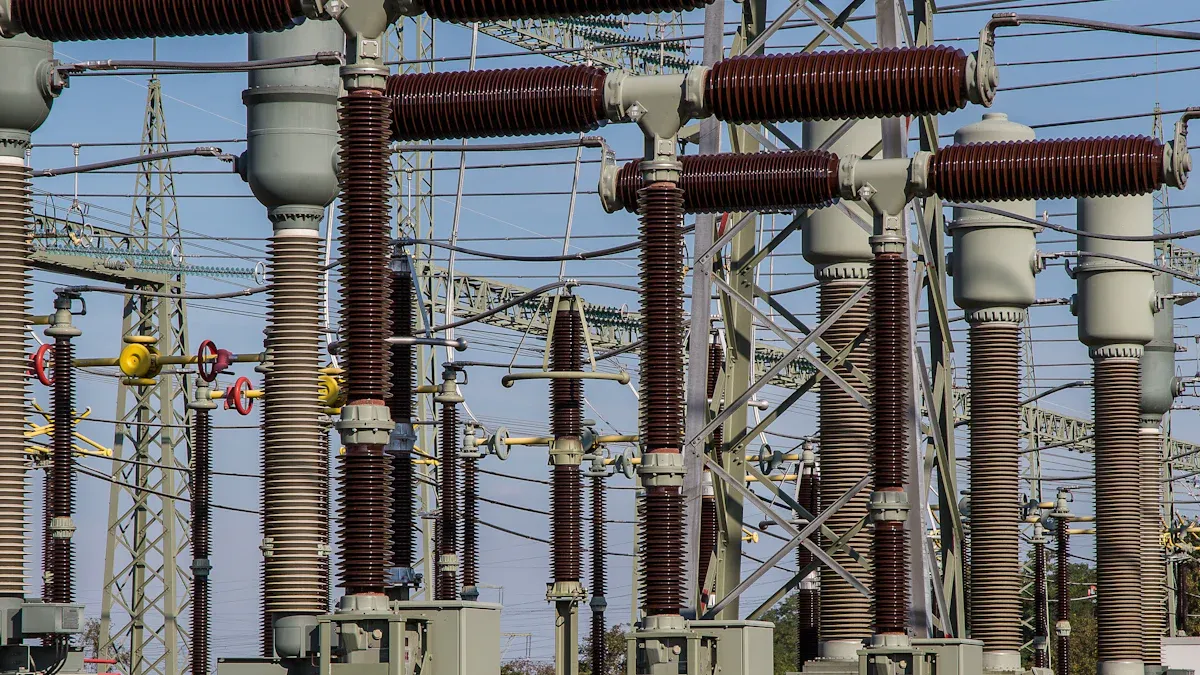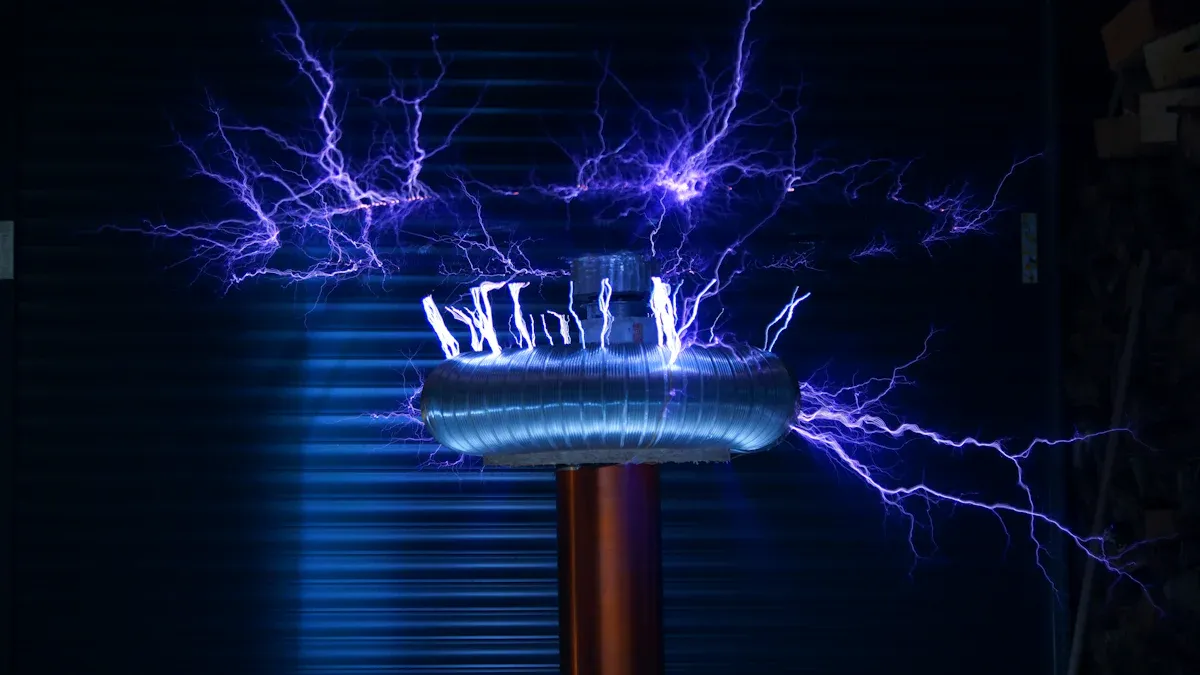What Is a Rectifier and Why It Matters

A rectifier is very important in modern electronics. It changes alternating current (ac) into direct current (dc). This provides steady power for many devices. Think of it as a bridge that makes unstable energy stable. For example, in electric car chargers, rectifiers help convert energy well. Things like power factor, total harmonic distortion (THD), and efficiency show how they work. A high power factor means energy is used better. Low THD keeps systems cleaner. High efficiency means less energy is wasted. These features make rectifiers key for powering electronics safely.
Key Takeaways
A rectifier changes alternating current (AC) into direct current (DC). It gives steady power to devices like phones and laptops.
Rectifier diodes let electricity move in only one direction. This makes them important for turning AC into usable DC power.
There are different rectifiers like half-wave, full-wave, and bridge types. They meet various needs and make devices work better.
Rectifiers are important in renewable energy systems. They help change and store energy from solar panels and wind turbines.
Using good rectifiers saves energy, improves performance, and makes electronics last longer.
How Does a Rectifier Work?

Understanding AC and DC Currents
To know how a rectifier works, you must first learn about alternating current (AC) and direct current (DC). AC is electricity that switches direction often. It is used in power grids because it travels far easily. DC, however, flows in one direction only. This makes it perfect for devices like phones and laptops.
Think of AC as a wave going up and down. DC is like a straight line. Most devices need steady electricity, which only DC provides. A rectifier changes AC into DC so your devices work properly.
The Role of a Rectifier Diode in Rectification
A rectifier diode is very important in this process. A diode is a tiny part that lets electricity flow one way. It acts like a one-way door for current. When AC enters the rectifier, the diode allows only the positive part to pass. It blocks the negative part.
This one-way flow turns AC into DC. Without the diode, this change would not happen. Advanced rectifiers use many diodes to work better and make smoother DC power.
The Process of Converting AC to DC
The steps to change AC into DC are:
AC Input: The rectifier gets AC from a power source, like a wall socket.
Diode Functionality: The diode lets current flow one way and blocks the other way.
Rectification Process: The diode changes AC into a pulsing DC.
Smoothing the Output: A capacitor smooths the pulsing DC. It charges during the positive cycle and discharges during the negative cycle, making the DC steady.
Bridge Rectifier Configuration: Four diodes in a bridge pattern ensure the output stays the same, no matter the input's direction.
For example, tests show bridge rectifiers are more efficient. In one test, a dual-tone input gave 54.3 μW of DC power with 54.3% efficiency. This proves how well rectifiers convert power.
Math models also explain this process. A multi-phase converter model shows how AC becomes DC. It uses special bridge parts and has been tested with generators and rectifiers. These models help design smart grids and check power quality.
By following these steps, a rectifier gives your devices steady and reliable DC power.
Types of Rectifiers

Rectifiers come in various forms for different tasks. Knowing these types helps you pick the best one. Let’s look at the three main kinds of rectifiers.
Half-Wave Rectifier
The half-wave rectifier is the easiest to understand. It uses one diode to change alternating current (AC) into direct current (DC). The diode lets only one part of the AC wave pass and blocks the other. This creates a bumpy DC output.
Did you know? Half-wave rectifiers are cheap and simple for small tasks.
But this simplicity has downsides. The output has many ripples, so it’s not great for devices needing smooth DC power. Engineers check its performance using these terms:
Metric | What It Means |
|---|---|
Peak Inverse Voltage (PIV) | Makes sure diodes handle voltage safely, avoiding damage. |
Ripple Factor | Shows how much the DC output fluctuates; lower is better. |
Transformer Utilization Factor (TUF) | Compares DC power output to the transformer's AC rating, showing efficiency. |
Output Waveform | Gives a bumpy DC output, making it less useful for steady power needs. |
Full-Wave Rectifier
The full-wave rectifier is better than the half-wave type. It uses both parts of the AC wave. This can be done with a center-tap transformer or four diodes in a bridge setup. The center-tap needs a special transformer, while the bridge uses regular diodes.
Full-wave rectifiers are more efficient and give smoother DC power. Here’s how they compare:
Rectifier Type | Efficiency | Output Voltage | Ripple Factor | Cost Implications |
|---|---|---|---|---|
Full Bridge Rectifier | High | Higher DC | Lower | Cheaper due to regular diodes |
Center Tap Rectifier | Lower | Lower DC | Higher | Costlier due to special transformer |
For medium or high-power needs, full-wave rectifiers are better. They provide steady power, helping devices work well.
Bridge Rectifier
The bridge rectifier is widely used for AC to DC conversion. It uses four diodes in a bridge shape. This design uses both parts of the AC wave without needing a special transformer.
Why is the bridge rectifier popular?
It changes AC to DC efficiently.
Both parts of the AC wave make the output smoother.
Capacitors can make the output even steadier for sensitive devices.
It’s affordable and works in many setups.
Tip: Bridge rectifiers may heat up in high-power uses. Cooling can help them work better.
Still, bridge rectifiers have limits. Diode voltage drops can lower efficiency, especially at high frequencies. Even so, their benefits make them a top choice for many systems.
Importance of Rectifiers in Practical Applications
Power Supplies for Electronic Devices
Rectifiers are vital for electronic devices like phones and laptops. These devices need dc power to work, but wall sockets provide ac power. Rectifiers change ac into dc, giving steady power to your gadgets.
They are also key in battery chargers. From small devices to electric cars, rectifiers ensure efficient and reliable charging. As more people use electronics and electric vehicles, rectifiers become even more important. Experts predict the semiconductor rectifier market will grow to USD 14.5 billion by 2033 because of their wide use in chargers and power supplies.
Fun Fact: Without rectifiers, your favorite gadgets wouldn't work at all!
Applications in Industrial and Household Electronics
Rectifiers power not only small gadgets but also big machines and home appliances. In factories, they provide steady dc power for machines to run smoothly. At home, rectifiers are used in TVs, refrigerators, and LED lights.
Good rectifiers make devices last longer and work better. They save energy and reduce the chance of breakdowns. Here’s how rectifiers help household electronics:
Characteristic | Description |
|---|---|
Reliability | Strong parts lower the chance of failure, making devices more reliable. |
Performance | Efficient rectifiers save energy and improve how devices work. |
Longevity | Durable rectifiers last longer, cutting down on replacements and repairs. |
Buying devices with efficient rectifiers saves money and makes them last longer.
Role in Renewable Energy Systems
Renewable energy systems like solar panels and wind turbines need rectifiers. Solar panels make dc power, but wind turbines create ac power. Rectifiers convert this energy so it can be stored or used in homes.
In smart grids, rectifiers control energy flow and improve power quality. They help renewable energy systems work better and more reliably. As clean energy becomes more popular, rectifiers are crucial for this change.
Tip: If you’re adding solar panels to your home, check the rectifiers. Good ones improve efficiency and reliability.
A rectifier is important for changing AC into DC power. It helps devices get steady electricity to work properly. Diodes allow current to flow in one direction only. Capacitors smooth out the power for better use. There are different types of rectifiers, like half-wave, full-wave, and bridge rectifiers. Each type works for specific tasks and needs. Rectifiers are used in phones, homes, and renewable energy systems. Without them, electronics would not work well. They are key for reliable and efficient energy in modern technology.
FAQ
What does a rectifier do?
A rectifier changes alternating current (AC) into direct current (DC). This gives steady power to devices like phones and laptops. Without rectifiers, many electronics wouldn’t work properly.
How do rectifiers save energy?
Rectifiers cut energy waste by turning AC into DC efficiently. Good rectifiers also reduce ripples, giving smooth power. This helps devices work better and last longer.
Are rectifiers used in renewable energy?
Yes! Rectifiers are very important in renewable energy systems. They change AC from wind turbines or DC from solar panels into usable power. This makes energy storage and use more effective.
How are half-wave and full-wave rectifiers different?
A half-wave rectifier uses one diode and converts half the AC wave. A full-wave rectifier uses both parts of the wave, making smoother and better DC power.
Why are bridge rectifiers common?
Bridge rectifiers are cheap and work well. They use four diodes to convert both parts of the AC wave into DC. This design gives smooth power without needing special transformers.
Tip: Pick a bridge rectifier for easy and reliable AC to DC conversion.
See Also
Top Three Reasons Why Telecom Rectifiers Matter
Telecom Rectifiers: Innovations Expected by 2025
Exploring Pros and Cons of Lead-Acid Batteries
The Superiority of Lithium Batteries in Telecom Systems
Distinguishing Communication Power Supplies from Standard Ones
CALL US DIRECTLY
86-13752765943
3A-8, SHUIWAN 1979 SQUARE (PHASE II), NO.111, TAIZI ROAD,SHUIWAN COMMUNITY, ZHAOSHANG STREET, NANSHAN DISTRICT, SHENZHEN, GUANGDONG, CHINA

